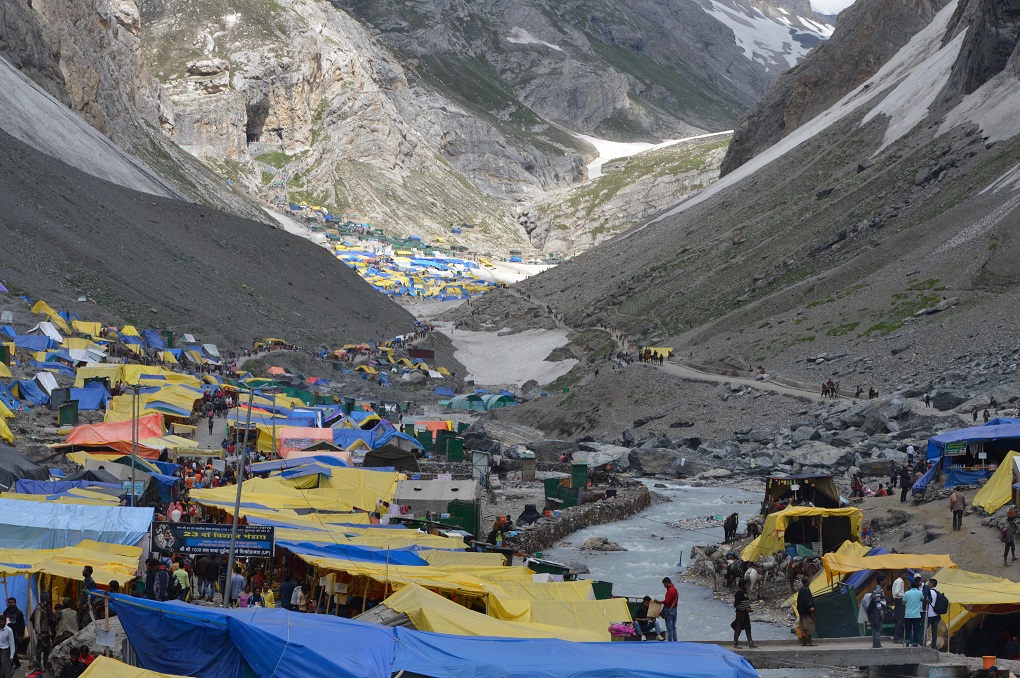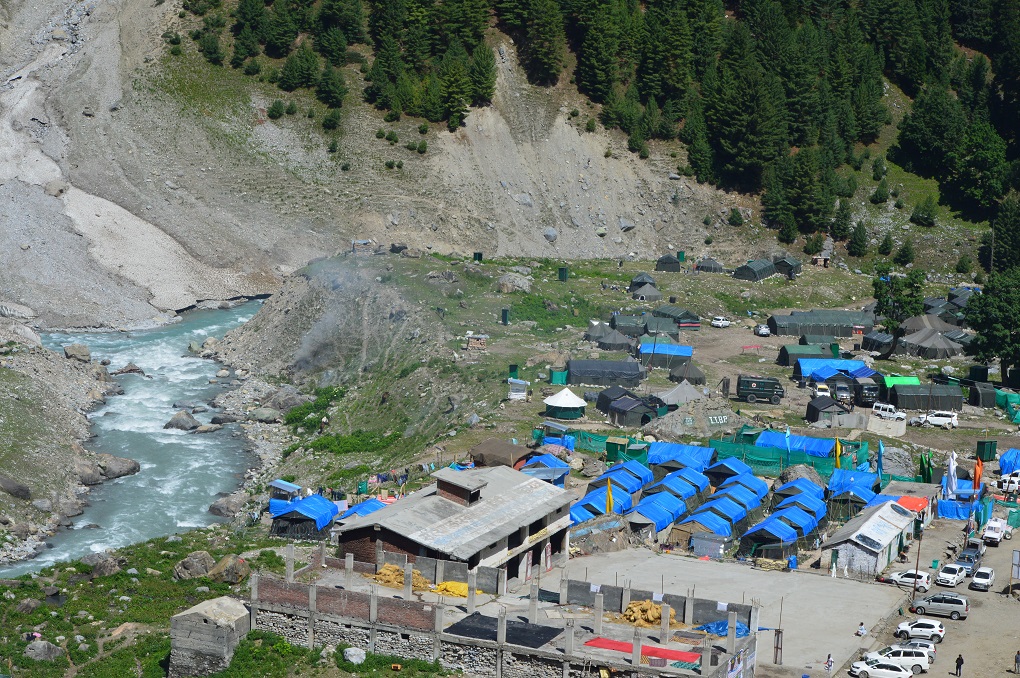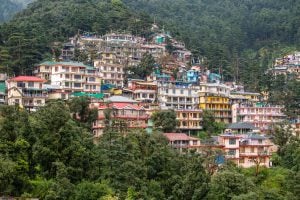As Covid-19 cases near 700,000 in India, the third-highest in the world, the government of Jammu & Kashmir has said that it is making all the necessary preparations for the Amarnath pilgrimage. For six week every year between July and August over half-a-million devotees make the long perilous trek, known as the Amarnath Yatra, to pay obeisance to an ice stalagmite believed to be an embodiment of the Hindu deity Shiva.
There has been a steep rise in the number of visitors to the shrine in recent years. Official data indicates that the number of worshippers has increased from 4,500 in 1950 to 353,969 in 2013 and 342, 883 for 32 days of the curtailed pilgrimage last year.
The Amarnath shrine is in a cave 3,888 metres above sea level in the Lidder Valley, which has a large concentration of small and large glaciers such as Kolahai, Nehnar and Bodpathri. It is approachable through two different routes – via Pahalgam in south Kashmir and Baltal in north-east Kashmir. Both are narrow tracks snaking through a stunning landscape and mostly flanked by steep cliffs.

It takes almost two-and-a-half days to cover the 46 kilometres from Pahalgam, while the 14 kilometres to the cave from Baltal is usually covered in five to six hours. Both Pahalgam and Baltal are around 95 kilometres from Kashmir’s summer capital, Srinagar. Thousands of pilgrims also opt for the aerial route using helicopters to avoid the hard trek.
Terror threats and yatra
Despite the violence in Kashmir over the past three decades, the Amarnath pilgrimage has only been targeted twice. In 2000, at least 21 pilgrims were killed and in 2017 seven pilgrims were gunned down. After the 2017 terror attack, the Indian security agencies have repeatedly issued security warnings for Amarnath pilgrims.
Last year, the government abruptly called off the pilgrimage on August 2 citing security concerns. “Keeping in view the latest intelligence inputs of terror threats, with specific targeting of the Amarth Yatra, and given the prevailing security situation in the Kashmir Valley, in the interest of safety and security of the tourists and Amarnath yatris, it is advised that they may curtail their stay in the Valley immediately and take necessary measures to return as soon as possible,” read the government order.
Two days later, India’s parliament passed an act that undermined the semi-autonomous status of Jammu & Kashmir under Article 370 of the Indian constitution. While no such security threat materialised, there has been an ongoing security and communication clampdown, which has been only ameliorated to a degree. Thousands of people, including senior politicians, remain in detention; there is no elected legislature and internet speeds are restricted.
The abrupt cancellation of the pilgrimage last year led to much criticism from the opposition, which may be why the government is keen to make sure it happens this time, said political observers. “The Amarnath Yatra has been made a totally different religious pilgrimage in recent years, ever since BJP [Bharatiya Janata Party] took the reins of power in New Delhi in 2014. A lot of symbolism has been attached to it in these years,” said a Srinagar-based political analyst speaking on condition of anonymity.
“This symbolism makes it even more difficult for the government in New Delhi to cancel the yatra this year,” he said, adding that authorities would prefer to organise the yatra for a short duration with little participation than cancel it. “That is why a lot of security has been deployed in Ganderbal district where the Baltal route, the only route to be used for Yatra this year, passes through,” he said.
The duration of the pilgrimage has been curtailed this year to 15 days and will likely begin from July 21 (and conclude on August 3) via only Baltal route (normally, pilgrims use both the Pahalgam-Chandanwari as well as Sonamarg-Baltal route in Ganderbal), according to reports published in various media outlets. But, Anok Soli, additional chief executive of the Shri Amarnath Ji Shrine Board, told The Third Pole that the final dates are yet to be decided. He also declined to comment on whether there was any pressure to organise the Yatra. “I will not comment on this or the exact dates of Yatra. I will also not comment about the security arrangements,” Soli said.

Covid-19 and religious rituals
In other parts of India, religious festivals have either been cancelled or severely curtailed. On June 4, India’s federal government, after allowing the reopening of places of worship, issued a set of standard operating procedures (SOPs) to be followed at religious places across India, asking people to avoid physical contact and maintain hygiene. Days before the government approval, representative bodies of different faiths had given assurances that they should be allowed to visit the places of worship saying they would observe due caution.
For the first time, Mumbai’s Lalbaughcha Raja Ganeshotsav Mandal has decided to cancel Ganeshotsav (Ganesh Chaturthi festival) this year owing to the pandemic, saying the religious organisation would instead set up a blood donation camp. Each year, Ganeshotsav is celebrated in a lavish manner in Mumbai, where hundreds of thousands of devotees participate to seek a blessing from Lord Ganesh.
The Indian Supreme Court had initially restrained temple authorities in the eastern state of Odisha from taking out Puri Rath Yatra (pilgrimage) this year on June 18 because of a “danger” to public health. On June 23 it modified the order to allow the Yatra directing that the “bare minimum number of people” who are Covid 19-negative will be allowed to attend the rituals associated with the pilgrimage.
On the same day, the government in Jammu & Kashmir held a meeting of dozens of officials to review the arrangements for the Amarnath pilgrimage.
“Though the decision regarding Yatra shall be taken appropriately in due course of time, but he [Girish Chandra Murmu, Lieutenant Governor of Jammu & Kashmir] insisted to make all basic preparations including health, infrastructure, ration/LPG supply, power, drinking water, security arrangements, telecommunication, disaster management etc,” a press statement from Jammu & Kashmir government’s information department said.
According to media reports, on July 5 Murmu conducted the first ritual of the season at the cave in his capacity as chair of the Shri Amarnath Ji Shrine Board.
Quoting unidentified official sources, the news agency Press Trust of India said that the yatra will be conducted in the last week of July. It quoted the chief secretary of the Jammu & Kashmir government, BVR Subrahmanyam as saying, “The Yatra this year will have to be undertaken in a restricted manner so that the SOPs for Covid-19 are strictly adhered to during the conduct of the yatra… a maximum of 500 yatris only could be allowed per day by road from Jammu.”
In stark contrast, the government passed an order on July 4, 2020 which states that: “all social / political / sports / entertainment / academic / cultural / religious functions and other large gatherings and congregations” are not permissible. “Religious places / places of worship shall continue to remain closed for public till further orders.”
This would not be the first time that the government has looked the other way when it comes to the Amarnath pilgrimage. Its ecology has long been neglected to cater to the large number of pilgrims.
Mohammad Sultan Bhat of Kashmir University’s geography department carried out the environmental impact assessment (EIA) of Pahalgam area a few years ago. He said that the Lidder Valley has a carrying capacity of 4,300 people on a single day. But, as the figures on the official website of Shri Amarnath Shrine Board show, such inputs are conveniently overlooked.
Locals in Kashmir have expressed shock and surprise over the government’s decision to allow the pilgrimage at a time when such religious events across India have mostly been cancelled because of the Covid-19 pandemic.
“If Tirupati Balaji Temple is shut and all the major temples and mosques are out of bounds for worshipers, why allow 500 pilgrims per day at Amarnath shrine?” asked rights activist Raja Muzaffar, who also heads the Jammu & Kashmir RTI Movement.
![<p>Thousands of devotees make the long perilous trek, known as the Amarnath Yatra, to pay obeisance to an ice stalagmite in the Amarnath cave believed to be an embodiment of the Hindu deity Shiva. [image: Alamy]</p>](https://dialogue.earth/content/uploads/2020/07/K0N8EY-scaled.jpg)




![Flooding along the Bagmati is an annual phenomenon in Bihar [image: Alamy]](https://dialogue.earth/content/uploads/2020/07/Floods-hit-Bihar-300x197.jpg)



